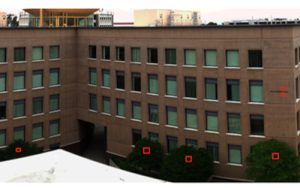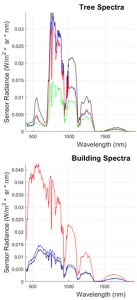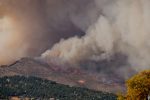Computer Vision Laboratory
 The Computer Vision Laboratory (CVL) specializes in the modeling and automated analysis of hyperspectral and multispectral data acquired by advanced image sensors over the visible through long-wave infrared wavelengths for a wide range of applications.
The Computer Vision Laboratory (CVL) specializes in the modeling and automated analysis of hyperspectral and multispectral data acquired by advanced image sensors over the visible through long-wave infrared wavelengths for a wide range of applications.
 Professor Glenn Healey is the director of the CVL and leads a multidisciplinary team with expertise in physical modeling, signal/image processing, numerical analysis, and machine learning. CVL researchers are actively deploying hyperspectral and multispectral image sensors as part of ALERTCalifornia to improve resilience against wildfires by the continuous characterization of the pre-fire, active fire, and post-fire environments over wide areas. These sensors provide the ability to continuously monitor vegetation moisture content which has a strong relationship with ignition probability and fire spread rate. These instruments also provide the ability to detect subpixel flame instances and to quantify fire characteristics and emissions through smoke as well as to track post-fire vegetation recovery. In addition, these sensors have application for the continuous wide-area assessment of air quality to quantify and mitigate climate change risks.
Professor Glenn Healey is the director of the CVL and leads a multidisciplinary team with expertise in physical modeling, signal/image processing, numerical analysis, and machine learning. CVL researchers are actively deploying hyperspectral and multispectral image sensors as part of ALERTCalifornia to improve resilience against wildfires by the continuous characterization of the pre-fire, active fire, and post-fire environments over wide areas. These sensors provide the ability to continuously monitor vegetation moisture content which has a strong relationship with ignition probability and fire spread rate. These instruments also provide the ability to detect subpixel flame instances and to quantify fire characteristics and emissions through smoke as well as to track post-fire vegetation recovery. In addition, these sensors have application for the continuous wide-area assessment of air quality to quantify and mitigate climate change risks.
Computer Vision Lab in the News
- Climate Change Experiment Explores Ecosystem Sensitivity
 Researchers collaborate to unlock the mysteries of California’s wildlands.
Researchers collaborate to unlock the mysteries of California’s wildlands. - Fire’s Secrets Exposed
 CVL’s visionary quest to revolutionize rapid fire response.
CVL’s visionary quest to revolutionize rapid fire response.
INFRASTRUCTURE
CALIT2
California Institute for Telecommunications
and Information Technology
4100 CALIT2 Building
University of California, Irvine
Irvine, CA 92697
(949) 824-6900
Fax: (949) 824-8197
© CALIT2, University of California, Irvine 2025
